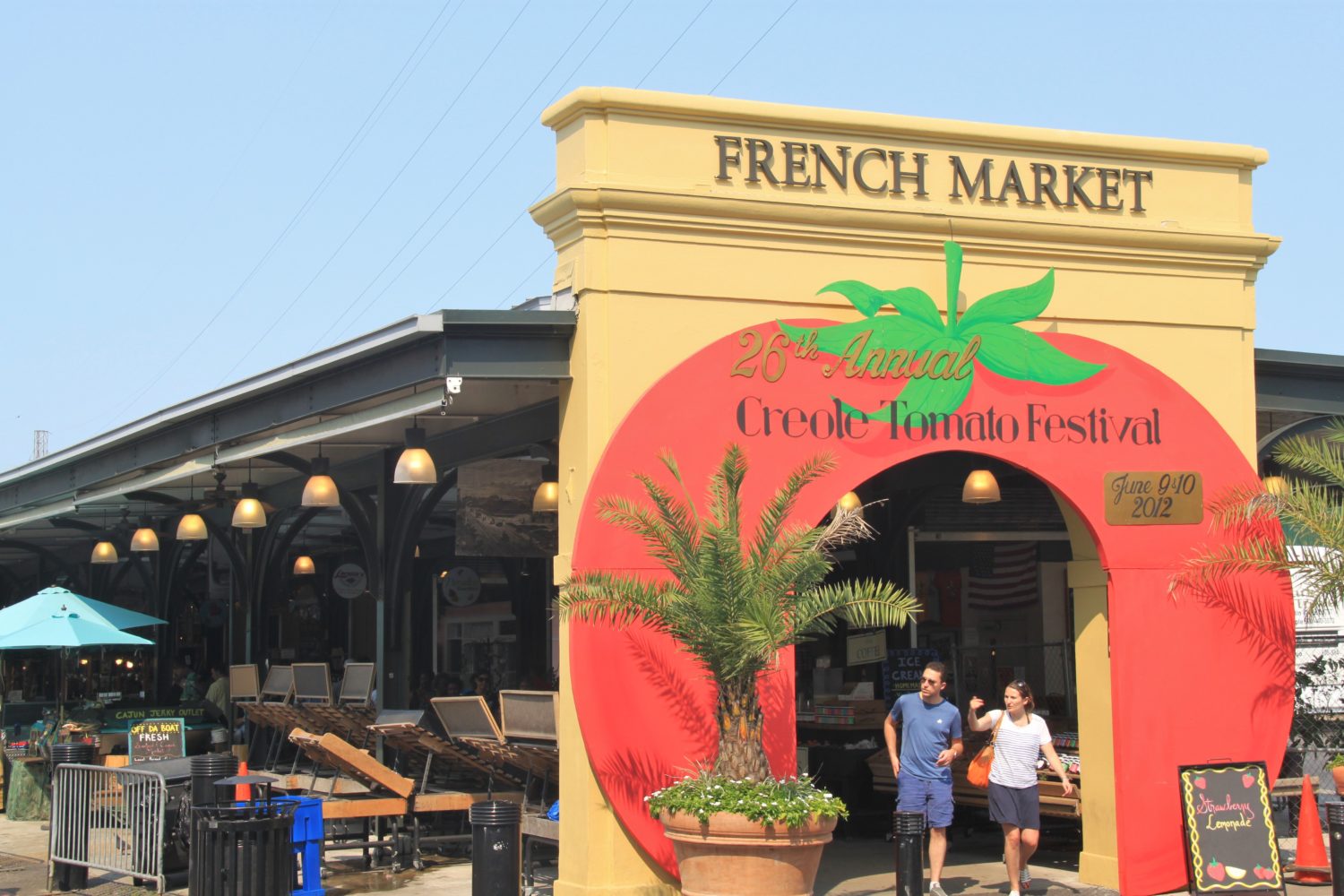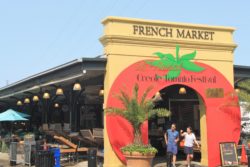Latest
On Tomatoes and South Louisiana Cooking
Delicious or blasphemous? The debate continues.
Published: April 30, 2020
Last Updated: July 30, 2020

Photo by Robert Gloeckner
Creole Tomato Festival.
In 2018, the Louisiana Endowment for the Humanities, with support from Union Pacific, offered Make It 300! grants in support of public programs celebrating the New Orleans Tricentennial. One of the projects funded was the Louisiana’s Culinary Heritages Round Table, a conversation held at The Historic New Orleans Collection as part of the American Council for Quebecois Studies bi-annual symposium on November 3, 2018. Six panelists representing various viewpoints and fields within Louisiana cuisine gathered to hold forth on the state’s stories foodways. In the below excerpt, edited and condensed for clarity, the participants take on a particularly contentious subject: tomatoes in South Louisiana cooking.
Moderator: Robin White, Associate Professor of English and French at Nicholls State University
Participants:
Dr. Ibrahima Seck, Director of Research at the Whitney Plantation and author of Bouki Fait Gombo
Dr. Justin Nystrom, professor of history at Loyola University and author of books including Creole Italian and Shaping of New Orleans Food Culture.
Poppy Tooker, host of Louisiana Eats and author, most recently, of Drag Queen Brunch
John LaFleur, author of Louisiana Food Culture: A Menu of Diversity
Marcelle Bienvenu, instructor and chef at the John Folse Culinary Institute at Nicholls State University
Shawanda Marie, culinary storyteller and owner of New Orleans Creole Story Pot
Robin White: … somebody at the round table yesterday said “gumbo and tomatoes together,” and that is a hot debate in Louisiana. Why the hate with the tomatoes in the gumbo? And we also talk about “red gravy” and marinara sauces; that we have a tradition of calling in Louisiana a certain kind of sauce you put on spaghetti Louisiana “red gravy.” We are going to move on to tomatoes.
Marcelle Bienvenu: Let me go back to my thoughts about the [Georgia and South Carolina coastal] Low Country. We share a lot of the same foods. We have okra, the Gullahs have okra, and sweet potatoes and beans, and I see such similarities of ingredients, just prepared differently. I think that that happened because of where [people] settled, with Gullahs probably more true to what they came with. In New Orleans, they [people of African descent] did mesh with the Italians, the Spanish, and whatnot. Going back to the tomatoes in gumbo, in south Louisiana, where I am from we never did have any. I came to work at Commander’s Palace in the early 70s, and the first thing I ate was a seafood okra gumbo, and it had tomatoes in it. I called my mother up, and I said, “Mom, they have tomatoes in there, and she said, ‘don’t eat it.’”
But then I had to call her on it. I said, “You know, mom, when you put up okra during the summer? You cook it with tomatoes. She said, ‘That doesn’t count.’” And so I really started looking at the gumbos in New Orleans at the time. It was kinda Paul Prudhomme came on the scene with seafood okra gumbo. And they did have a little bit of tomato in the product. Not a lot; it certainly wasn’t red. It was brownish red or sienna colored, and it didn’t have a pronounced flavor of tomato. And I personally have gotten to like it with a little dash in there, because I think it adds a lot of flavor and color. In one of our classes at the John Folse Culinary Institute, we have gumbo day. There are eight kids in that class, and it’s all the same recipe, but they’re all different. They’re all different colors, but they all have the same ingredients, the same directions, so I always say: whoever is stirring the pot, it’s gonna come up different. You can go all through South Louisiana and everyone has their own version of gumbo. I always ask, “Who makes the best version of it?” “Maman, or grandfather,” because it’s someone in their family who makes the best whatever, right? Cause you grew up eating it.
White: Okay, Justin, let’s discuss the tomatoes.
Justin Nystrom: I put a little tomato paste in my gumbo.
White: I am not judging you.
Nystrom: It thickens it up, and it gives it a little more complexity, and I think authenticity is a spongy thing when it comes to food. and I think that to ask if something is “authentic” might not actually be the right question.
Poppy Tooker: Well, if I can venture just a teeny bit beyond gumbo, since you brought up red gravy. You know here, we have this very red sauce that we call Creole sauce, and so I can’t really tell you when the Creoles fell in love with that tomato, and the tomato became so prevalent in everything from New Orleans gumbo to New Orleans jambalaya. The one thing that always stands out in my mind when it comes to Creole and red is that I have had the great pleasure of cooking many many many times with Leah Chase. She always tells me, “You know you’ve got a brown gravy,” and Leah says the Creoles always put some paprika in it. Now, that’s the sweet Hungarian paprika that I find often adds more color than flavor. We didn’t know about the smoked stuff from Spain until it surprised us one day, and it doesn’t belong in a rémoulade or a lot of other places, but Leah said, “Paprika goes in those dishes because Creoles just love red, we love red.” I always defer to my 94-year-old friend Leah Chase and her institutional memory. That’s all I can say about that.
Ibrahima Seck: I am a West African and a Senegalese, I think tomato in your gumbo is just putting sugar in your honey. And I know many people who eat gumbo, and they never eat tomatoes. The jambalaya, what we call thieboudienne or ceebu jen, is made with rice and fish. Don’t put tomato in there, they won’t eat it.
White: So maybe that’s where it comes from. It might come from Africa because I know people have strong feelings about tomato in gumbo.
Seck: We use other thickeners. We don’t make a roux like you do here. We use peanut butter as a thickener, and we use palm oil. That can be red and can be used in Senegal. But not tomato. Pas de tomates.
John LaFleur: I take the historical chronological approach so that we can see the evolution and the progression of creolization vis-à-vis the foodways that are all tied to that. The tomato was a New World gift that was later exported to Europe. The Indians, the earliest Native Americans knew the tomato, and they did use it. Le Page du Pratz, from the founding year of New Orleans, writes of many unknown elements that the Choctaw used in their cooking. In the country where the Creole Métis settled, the people [who] were the children of the Choctaw and colonial French people, like in old New Orleans, and more like in the African tradition, they did not abuse tomatoes and use tomato sauces. I once had guests who decided to treat me, and we went to a very nice restaurant here. I loved the architecture, but I was horrified by seeing the drenching of tomato sauce in a gumbo and jambalaya that was virtually inedible to me. I could not eat it. Maybe I have stronger African genes than I realize, but it was a bloody mess. And in the country, in the country, the rural parishes where Leah and several of us come from, we don’t abuse tomato sauce in sauce piquante, whether it’s turtle or chicken sauce piquante. We have a hint in shrimp Creole, we have a hint of the tomato sauce primarily for coloring. If you want a New Orleans rendition, they call it shrimp Creole and add whole tomatoes and quartered bell peppers for looks, but in the country there’s no pretensions. The tomato sauce is not the abusive thing you see like in some restaurants, which I don’t believe is representative of New Orleans Creole. I think that that was a later improvisation by those who got excited and thought that everything was Creole and threw that pan of tomato sauce into it. But in the country, the tomato sauce is used as a slight enhancer. And of course, in some cases like with courtbouillon, that’s like, again, it’s never abusive, and some of the finest and oldest Creole people who have had restaurants in the city of New Orleans have told me the same thing in my interviews, and I was fortunate enough to grow up with old people. In the country, we still speak the old colonial French that united everyone and that Michaela Almonaster was guilty of speaking of so well and was so criticized by the Parisians that were too happy to come to her parties and imbibe her excellent cuisine and cocktails.
So the use of tomatoes is a gift from the New World. It’s always been here. We must never forget that the first creolization that begins in the context of Louisiana was the Native Americans with the colonial Euro-French and Caribbean peoples. With the arrival of the West Africans, they were brought into the gumbo pot, a multi-ethnic blend. Every Creole colony is not the same. Every Creole patois of French spoken, across the former French empire is not the same. When we speak of Cajun French, that’s not Acadian or Canadian French. That is the French of Louisiana, that my ancestors on my mother’s side learned along with the cuisine, which they did not bring to Louisiana but learned and adapted. Don’t ask for gumbo in Canada.
White: On that note, Shawanda, what are your thoughts on tomatoes? And don’t you have roots in St. James Parish, as well? You’re not just a New Orleanian, you are a St. James and New Orleanian. Am I wrong?
Shawanda Marie: Absolutely correct. My maternal paternal side comes from St. James Parish, Vacherie, Louisiana. As a matter of fact, Whitney Plantation and Evergreen Plantation. Yeah. Honestly, don’t put corn in my gumbo. But I’ve never grown up eating tomatoes in my gumbo. It’s frustrating when people say that your Creole identity is linked to the fact that you have tomatoes in your gumbo, which isn’t necessarily true.
Spoiling for a fight after talking tomatoes in gumbo? Read more fighting words in “Notes from a Gumbo Road Trip” from our Fall 2019 issue.
